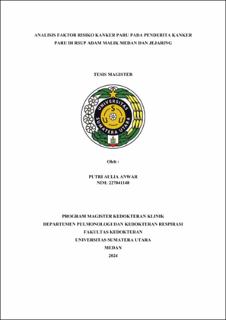Analisis Faktor Risiko Kanker Paru pada Penderita Kanker Paru di RSUP Adam Malik Medan dan Jejaring
Risk Factor Analysis of Lung Cancer in Lung Cancer Patients at RSUP Adam Malik Medan and Network Hospitals

Date
2024Author
Anwar, Putri Aulia
Advisor(s)
Soeroso, Noni Novisari
Tarigan, Setia Putra
Eyanoer, Putri Chairani
Metadata
Show full item recordAbstract
Background and Aims : This study aims to identify the risk factors of patients
diagnosed with lung cancer in several healthcare facilities located in one of
Indonesia's largest cities, Medan, North Sumatra. Understanding the background of
lung cancer patients identified in a specific region is expected to assist clinicians in
early diagnosis or even in preventing future lung cancer cases.
Methods : This research employed an observational analytic study design with a
case-control approach, involving histopathologically confirmed lung cancer patients
and control groups from June to November 2024. Data collected included smoking
behavior, demographic characteristics, exposure to carcinogenic substances at work
and home, and history of prior lung diseases.
Results: The study revealed that the majority of lung cancer patients were aged 59
on average, with 75% being male. Major risk factors included smoking behavior,
with active smokers having the highest risk compared to former and passive
smokers. Air pollution exposure, both at the workplace (45.6%) and home (47.7%),
was also significantly associated with an increased risk of lung cancer. A history of
lung diseases, such as COPD and TB, as well as a family history of cancer,
contributed to the elevated risk. Multivariate analysis showed that family cancer
history had the greatest influence (OR=10.65), followed by workplace pollution,
home pollution, and smoking behavior. Conversely, chronic lung disease history
was found to be a protective factor.
Conclusion: This study identified associations between risk factors such as
smoking behavior, exposure to carcinogenic substances at work and home, and
prior lung disease history with the occurrence of lung cancer. Further research in
other populations is needed to validate these findings.
